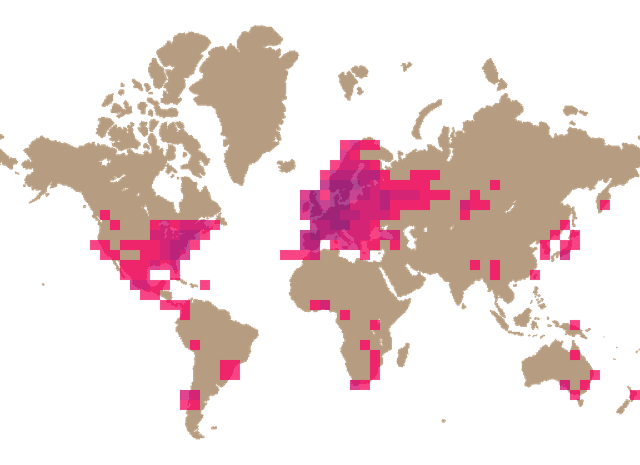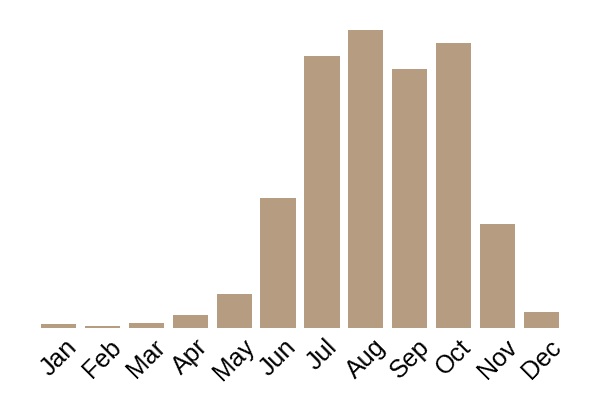One of the few Amanitas considered edible, primarily in Europe. Raw, it is very toxic, but unlike other Amanita species, its toxins are destroyed during cooking. Extreme caution is needed due to the presence of look-alike species; knowing the main distinguishing features will help you avoid mistakes.
The cap is 5-20 cm (2-8 in) in diameter, initially oval or egg-shaped, then bell-shaped, and finally convex or nearly flat. Its color varies greatly, ranging from reddish, brown, bronze-silver, brownish-gray, gray, to almost white. Sometimes, there are red spots on the cap that can resemble bloodstains. The entire surface is covered with light gray, pinkish, or whitish scales, remnants of the universal veil. These scales easily detach and can be washed away in rain or damp weather. The cap margin is slightly striated, especially in wet conditions.
The gills are close, soft, and free or connected to the stem by a thin line. They are white, often developing pink or rusty-red spots, which quickly appear when damaged or bruised.
The stem is 7-20 cm (2.8-8 in) long and 1-2.5 cm (0.4-1 in) in diameter, cylindrical with a swollen base, lacking noticeable rings from the volva remnants found in other Amanita species. The surface is fibrous and may match the cap color or be lighter. It can be light or nearly white above the ring and much darker, reddish-brown below. The stem may become hollow with age, and the flesh turns reddish upon exposure to air.
The flesh is white or pale brown, soft, especially with age. It reddens when cut or bruised. These mushrooms are often eaten by worms, resulting in the flesh turning red wherever they have been.
The ring is large, membranous, white. It covers the gills for a long time before becoming pendulous on the stem. The upper surface is striated. With age, it can thin and eventually disappear.
The volva is only noticeable in very young fruiting bodies. As the mushroom ages, it leaves only a swollen base of the stem without any prominent rings formed by the volva.
Solitary or in small groups.
Spore print is white.
They are found in coniferous and mixed forests, preferring acidic soils. Occasionally, they can also be found in glades and clearings.
The smell and taste are not particularly notable. It is not recommended to try it, as it is toxic when raw.
When raw, it is dangerous to consume due to a hemolytic toxin that causes anemia. However, thorough cooking can destroy this toxin, making the mushroom edible. Despite this, it is not recommended to consume it because there are many similar species, including many deadly ones whose toxins are not destroyed by cooking. Additionally, the Blusher itself is highly variable in appearance, making identification difficult.
Moreover, edibility data is based on specimens found in Europe. While it is believed the same species exists in North America, there is little information about its edibility.
One of the most dangerous look-alikes is the Panther сap, Amanita pantherina. This deadly poisonous mushroom not only resembles the Blusher in appearance but also grows in similar conditions, locations, and during the same season. Fortunately, there are distinguishing features between them.
The Blusher has fine lines on the ring, whereas the Panther сap's ring surface is smooth or wrinkled when dry, but never has radial lines.
As the Blusher ages, only a swollen stem base remains instead of a volva. In contrast, the Panther сap retains a volva and has characteristic encircling rings above it.
The surface and flesh of the Blusher redden when bruised or exposed to air, while the Panther сap does not.
- Foraging for mushrooms and other wild foods in the UK (2024) Wild Food UK. Available at: https://www.wildfooduk.com/ (Accessed: 26 June 2024).
- Hard, M.E. (2010) The mushroom, edible and otherwise its habitat and its time of growth. To be supplied: Project Gutenberg.
- Laessøe, T. (2013) Mushrooms: How to identify and gather wild mushrooms and other fungi. New York: DK.
- McKnight, K.H. and McKnight, V.B. (1987) A field guide to Mushrooms of North America. Boston: Houghton Mifflin.
- Your 2,300-page wildlife window on the World Wide Web (no date) Wildflowers, wild orchids, fungi, wildlife; nature books, reserves. Available at: https://www.first-nature.com/index.php (Accessed: 26 June 2024).

